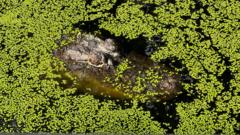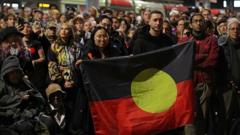Once on the brink of extinction, saltwater crocodiles in Australia's Northern Territory have rebounded to about 100,000, raising concerns about public safety and effective management. Rangers navigate tough decisions between culling and conservation while educating the public on living alongside these formidable creatures.
The Crocodile Conundrum: Managing Australia's Apex Predator

The Crocodile Conundrum: Managing Australia's Apex Predator
Australia's Northern Territory grapples with the burgeoning saltwater crocodile population, balancing conservation and community safety as their numbers soar.
In the heart of Australia’s Northern Territory (NT), an ongoing struggle unfolds—not to protect a species from extinction, but to manage its dramatic resurgence. Saltwater crocodiles, once nearly wiped out, have bounced back to a population of approximately 100,000, stoking debates on whether conservation or culling is the answer.
As dawn breaks over Darwin Harbour, government ranger Kelly Ewin stands at the helm, ready to engage with the powerful reptiles that are an integral part of the region’s natural landscape. “You get pretty much zero chances with these guys,” Ewin states, eyeing an agitated crocodile sequestered within a floating trap.
These feared predators were nearly hunted to oblivion in the mid-20th century due to a lucrative skin trade that decimated their populations. Following a hunting ban in 1971, numbers surged, prompting a complex dilemma: how to coexist safely with such aggressive creatures in areas frequented by humans.
The Northern Territory's environment supports the saltwater crocodile’s needs, allowing them to thrive in an ecosystem abundant with water and warmth. While attacks are infrequent, they do occur. Last year, the tragic fatality of a 12-year-old girl sparked contention over crocodile management, with local leaders insisting that crocodile populations must not exceed those of humans, estimated at around 250,000.
Education plays a critical role in maintaining this delicate balance. The "Be Crocwise" program educates local children on safe behaviors around potential crocodile habitats, and its success has prompted interest from regions like Florida and the Philippines.
Currently, mass culling is not on the agenda—saltwater crocodiles remain a protected species. However, a newly instituted 10-year crocodile management plan allows for an increase in the number of crocodiles that can be culled from 300 to 1,200 annually, a necessary action to minimize human encounters.
This equilibrium of coexistence and caution could be further complicated, as tourism thrives on the crocodile spectacle, with visitors drawn to shows exemplifying the majesty and danger of these reptiles. Crocodile farming, initiated post-hunting ban, has also surfaced as a significant economic driver, attracting investment from global luxury brands eager for crocodile leather.
Mick Burns, a veteran crocodile farmer, advocates the benefits of this industry for both conservation and local Indigenous communities, who have historically interacted with crocodiles for thousands of years. Yet, dissent exists within animal rights circles regarding the ethics of farming practices and animal treatment.
As residents of Darwin grapple with the echo of prehistoric giants, they share stories that juxtapose awe with fear. Despite the efforts to control and understand the crocodile population, caution remains essential. Prof. Grahame Webb succinctly encapsulates the danger: “If you go swimming in the Adelaide River next to Darwin, there’s a 100% chance you’ll be killed,” he states, underscoring the importance of responsible management of these apex predators.
The crocodile population surge poses a complex challenge, embodying the tension between conservation and public safety—a conversation with implications for ecosystems and communities far beyond the shores of Australia.




















